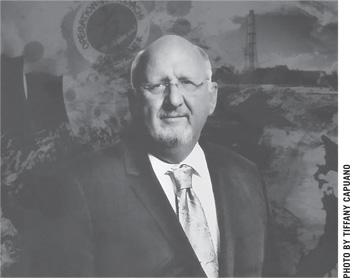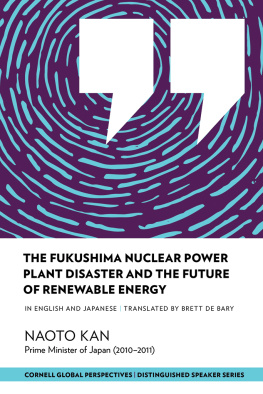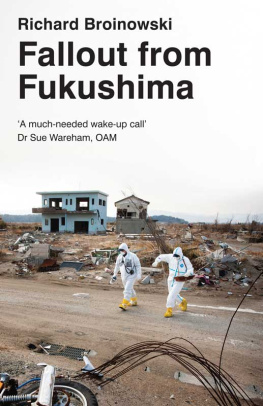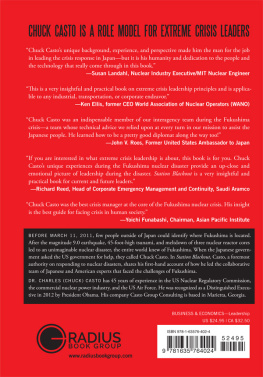




Distributed by Radius Book Group
A Division of Diversion Publishing Corp.
443 Park Avenue South, Suite 1004
New York, NY 10016
www.RadiusBookGroup.com
Copyright 2018 by Charles A. Casto
All rights reserved, including the right to reproduce this book or portions thereof in any form whatsoever.
Library of Congress Control Number: 2018954167
For more information, email .
First edition: December 2018
Hardcover ISBN: 978-1-63576-402-4
eBook ISBN: 978-1-63576-403-1
Manufactured in the United States of America
10 9 8 7 6 5 4 3 2 1
Jacket design by Mark Karis
Interior design by Pauline Neuwirth, Neuwirth & Associates
Radius Books and the Radius Books colophon are registered trademarks of Radius Books, Inc.
To the heroes of Fukushima Daiichi and Daini
CONTENTS


Taylors not gone. Shes just away from us. Taylors a volunteer in heaven right now.
S ISTER OF TSUNAMI VICTIM T AYLOR A NDERSON
I f you are a leader, an engineer, a disaster buff, or someone personally connected to or touched by the horrific events that unfolded on March 11, 2011starting with the Great East Japan Earthquake, followed by the tsunami, and then the Fukushima nuclear accidentit wouldnt be surprising that you might pick up this book, flip through it, and perhaps take it home or click buy . I hope so.
But if you are none of those, why might you be interested in the story of a disaster that occurred years ago at a remote nuclear facility? Because its an incredible story in and of itself. Even though I lived it, I could barely believe the scenes I witnessed.
The crisis leadershipthe courageous, often selfless initiativethat emerged from a group of those involved is also a big part of the story. The leadership lessons to be gleaned are of enormous value on so many planes.
Fifty minutes after the 9.0 earthquake hit the nuclear plant known as Fukushima Daiichi, a tsunami 45 feet high engulfed the facility, knocking out electrical power and all the reactors safety systems. These circumstances led to significant core damage in three of six reactors. Buildings exploded, unleashing unknown levels of radiation throughout the countryside. Operators faced countless dangers; two of them died while many others, even though fearing for their lives, carried out life-or-death missions to vent the reactor containments. There were no lights, no controls, no reason to stay, and every reason to flee. One operator said later, Three times, I thought that I would die.
Their boss, Ikuo Izawa, knew he had to guide them and give them a reason to stay through the challenges they faced. How does a leader lead in those conditions? How did Izawa get his workers to follow when their emotions and their common sense told them to leave? During those cataclysmic days, Izawa and others succeeded as leaders under the toughest possible conditions. The leadership lessons to be learned from these incredible experiences are invaluableand I have set out to tell the story with this topmost in mind.
This is a story of incredible heroism under desperate conditions that could have had catastrophic consequences. You will read about amazing feats carried out by leaders, individuals, and teams. You will read about tragedy on an unfathomable scale, about peoples lives ripped apart by disaster. You will read moving personal stories of courage, heartbreak, and hope.
What I have chosen to emphasize about these stories is the tightrope that leaders must walk to guide their organizations through crisis. You will see people overcome the primal urge to flee from death and instead walk a tightrope that would determine the fate of their country. You will read about the very specific ways that Japanese culture came into play throughout an unprecedented crisis, and how American support affected the recovery for better or worse. And finally, youll read about a country coming back to life after the unimaginable occurred, grappling with a new normal and pondering what actions and policies might prevent such a thing from happening ever again.
Think about a time when you met with resistance to your ideas, plans, thoughts, demands, or leadership. How did you get your unwilling followers to follow you? You are unlikely to experience an accident on the scale of the Fukushima Daiichi meltdowns, where the performance of your team may mean life or death. But you probably face smaller crises regularly, from lackluster performance to mergers to downsizing. By examining leadership in extremis , we open a window into human nature under pressure and gain valuable insights about effective leadership on a day-to-day basis. Leadership concepts that you grapple with all the time, such as trust, defiance, fear, and followership, all came into play at Fukushima Daiichi, where a few heroic leaders responded to the circumstances as best they could. Watching them in action may help you face your next corporate crisis.
Its also a hell of a story.
WHAT HAPPENED?
Its quite possible that you have only a vague notion of what happened at Fukushima Daiichi, so heres a brief overview. On March 11, 2011, the Great East Japan Earthquake struck the Tohoku region. The event is known as 3/11 in Japan, and everyone there remembers the many lives lost and the heroes who emerged much as we remember our own 9/11. The 9.0 earthquake was felt as far away as Antarctica. The Earth moved on its axis.
The ensuing tsunami was enormous, with multiple ocean waves as high as four- and five-story buildings. It overwhelmed villages up and down the Sendai Coast. It changed the regions landscape permanently by destroying roads, bridges, homes, and buildings. It swept tens of thousands of people and other creatures to their deaths in minutes.
Soon, Fukushima Daiichias well as its sister plant six miles south, Fukushima Daini, and other nuclear power plantswere without vital electrical power or cooling water needed to prevent a nuclear accident. Without these vital utilities, the reactors and spent-fuel pools would begin to melt down. Most of the emergency equipment, facilities, and first responders in the area had been wiped out by the earthquake and tsunami. It was imperative for the world to help Japan rescue the living, recover the lost, minimize nuclear meltdowns, and repair the heavily damaged infrastructure.
Hundreds of square miles of contaminated land were rendered uninhabitable for years to come. Eventually, approximately 160,000 people would evacuate from around the crippled nuclear plants. Among those in danger were about 153,000 American expatriates, plus innumerable tourists.
Understandably, all this damage knocked Japan to its knees. Fear coursed throughout Japan and the world. But heroes emerged in those days. Untold numbers of Japanese rose to the challenge, as well as thousands of Americans after President Obama authorized Operation Tomodachi (friendship)the first American military operation to have a foreign nameto help rescue, recover, and supply the people of Japan. Twenty U.S. ships; 140 aircraft; 19,703 military personnel; 160 search-and-rescue missions; and National Guard troops from Mississippi, Alabama, Kentucky, and Guam responded. Cub Scout packs, church groups, and schoolchildren gathered contributions for the victims.
Next page













